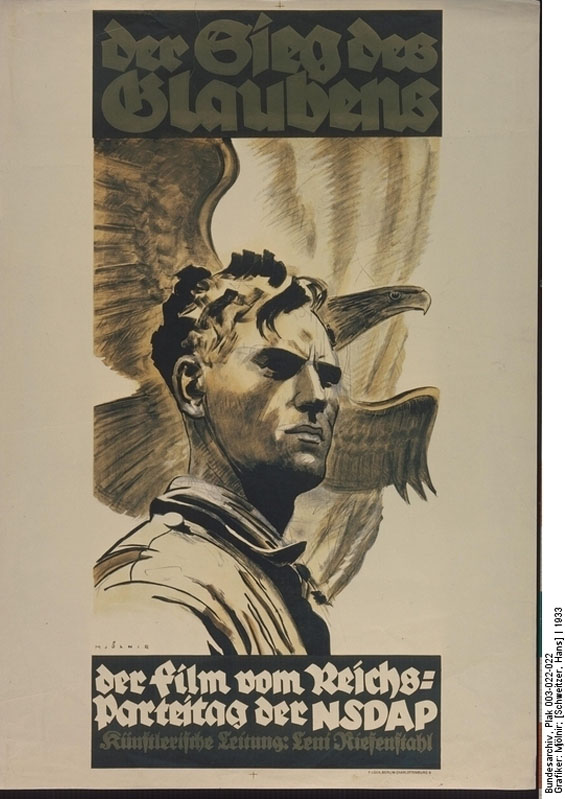Source

Source: The Victory of Faith [Der Sieg des Glaubens], film poster, 1933. Designer: Mjölnir [Hans Schweitzer], published by Franz Lück, Berlin. Bundesarchiv, Plak 003-022-022.
The National Socialists were quick to recognize the power of the new medium of film and used it, along with radio, as one of their preferred propaganda instruments. In 1933, director Leni Riefenstahl (1902-2003) filmed a documentary about the NSDAP’s Fifth Party Rally, which took place from September 1-3 in Nuremberg. The film was called The Victory of Faith [Der Sieg des Glaubens] – the title refers to the fact that the Fifth Party Rally was the first party rally to take place after Hitler took power (i.e., after the victory). For this reason, the rally was also called “The Party Congress of Victory” in NSDAP propaganda. The film premiered in the Berlin Ufa-Palast am Zoo on December 1, 1933, and was a great propaganda success. After the Röhm affair, however, the screenings were halted and most copies of the film were destroyed, because Ernst Röhm appeared in The Victory of Faith at Hitler’s side. The sixty-minute film was long thought to be lost until a copy was found in 1986.
Adolf Hitler had personally commissioned Leni Riefenstahl to make the film. The two were bound by a close friendship that provided the foundation for Riefenstahl’s brilliant career during the Nazi dictatorship. Hitler believed that the talented director was the right person to portray the party rally as a thrilling and emotional mass event and to present himself as a charismatic leader. She later produced other propaganda films that also won international acclaim, such as The Triumph of the Will, The Day of Freedom, and finally her best-known work, a two-part film on the 1936 Olympic Games (The Festival of the Peoples and The Festival of Beauty), whose artistic and technical quality established her reputation even beyond the Nazi dictatorship. Riefenstahl herself always denied any complicity with or support for the Nazi regime. In 1948, a denazification court categorized her as a “follower.” However, she was not able to refute the accusation that while making the film Tiefland (1940-41), she had forced a group of Gypsies to participate and that – contrary to her claims – had not saved them from being deported to Auschwitz. Thus she remains controversial, and her career is considered exemplary of those artists who not only benefited from Nazi cultural policies but also willingly accepted the ideological appropriation of their work.

Source: The Victory of Faith [Der Sieg des Glaubens], film poster, 1933. Designer: Mjölnir [Hans Schweitzer], published by Franz Lück, Berlin. Bundesarchiv, Plak 003-022-022.